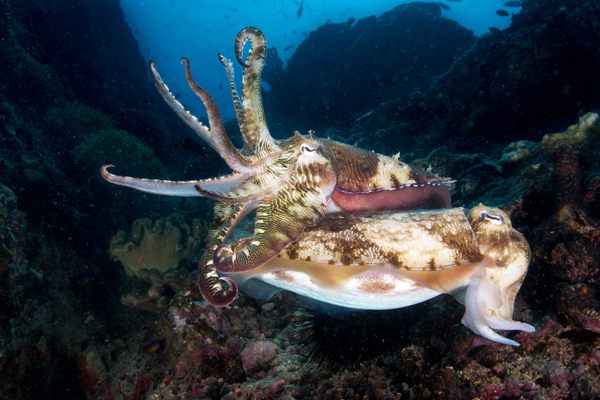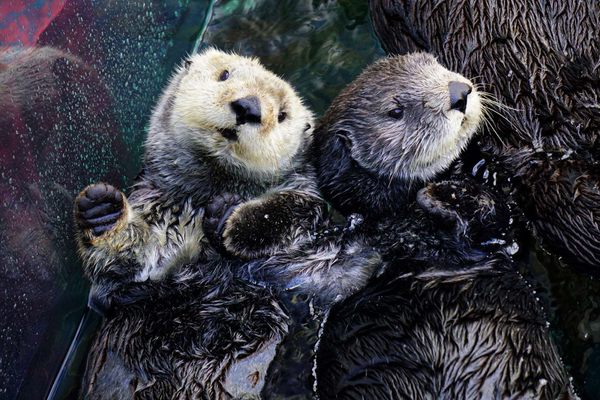
It Takes a Lot of Odd Jobs to Keep a Massive Aquarium Running
And they all involve developing a close relationship with the aquatic world and its inhabitants.
From the ancient Sumerians, who built some of the world’s first fish ponds in 4500 B.C., to the Romans, who managed to keep seawater flowing into seaside enclosures, humans have been working to keep aquatic species alive on land for a long time. Many of these fish and other species were kept for food, but wonder played a part, too. During China’s Tang Dynasty (618–907) people started to breed colorful carp for ornamental purposes. By 1611, porcelain bowls containing the ancestors of today’s goldfish were traded from China to Europe as exotic home accessories.
But it wasn’t until the 18th century that live marine life was made accessible—the way we have it today—for educational and research purposes. The world’s first aquarium opened its doors within London Zoo in May 1853, after British zoologist Philip H. Gosse was able to replicate a marine ecosystem in a see-through glass tank. Gosse, who also coined the word “aquarium,” wished for it to serve as a place for people “to get acquainted with the peculiar creatures of the oceans.”
Today, aquariums all over the world still serve this purpose by offering the opportunity to come in close contact with the wonders of the deep (and not so deep). Atlas Obscura recently gained behind-the-scenes access to Italy’s largest aquarium, the Aquario di Genova or Aquarium of Genoa, to learn about what it takes to keep some 12,000 marine creatures alive—and how getting acquainted with the creatures of the oceans is the most important job for the marine biologists, curators, technicians, and others on staff.

Located at the old harbor of Genoa, the 33,000-square-foot aquarium was designed by Genoese architect Renzo Piano for the 1992 World Expo. It employs around 100 people in education, conservation, and research activities, and hosts some 600 species, including manatees, scorpionfish, piranhas, and golden “sea nettle” jellyfish. Caring for these creatures requires a host of tasks, from feeding to cleaning to medical care, that take place far from the view of the general public.
Take the West Indian manatees, also known as “sea cows.” In coastal portions of the Atlantic and Gulf of Mexico, they thrive on a diet of seaweed and floating plants. So the staff at Genoa experimented with locally sourced produce to find the right diet for them. “We tried feeding them different veggies like carrots, beets, and spinach to see what they loved the most,” says Erika Esposti, a marine mammal supervisor. “Eventually, we settled on a combination of lettuce, fennel, and beets with the occasional banana.” It takes four people to feed the aquarium’s three manatees each day, with around 90 pounds of fresh produce, mostly procured from local farms.
The manatees must be fed every day, but not the sharks. “We tend to think of sharks as hungry predators but we need to feed them only three times a week,” says Laura Castellano, who curates the Mediterranean and cold water sections of the aquarium. The dolphins, on the other hand, are fed three times daily with a mix of herring, calamari, and capelin, but it’s not so simple as tossing a bucket of fish in the water. “Dolphins are playful creatures and get bored easily,” Esposti explains, “so the trick is to avoid predictable routines.” Feeding sessions are supplemented by a more interactive approach, such as placing food in perforated floating containers. “Most dolphins love to push these around to get the food out,” Esposti says.

It’s not just feeding that needs to be matched to each species’ idiosyncrasies—so do vet visits. Species that come out of the water for their checkups, such as seals, require special attention and trust-building.
“Seals are used to spending time out of the water,” Esposti says. “The tricky part is understanding the right moment to get them out.” Seals, like many mammals, are social creatures and sensitive to their position in the social hierarchy. Getting out of the water makes these status-conscious creatures feel vulnerable, so it can only be done when they are in a good position socially. So Esposti must spend hours taking note of each seal’s behavior in the days prior to a medical check. “It can only work if they trust us,” she says. A nervous seal could tense up, making it hard to take blood. “It can take months of preparation to take a blood sample from one of our seals,” Esposti says.
Fine tuning the right environment for each species is crucial too, says Silvia Lavorano, curator at the tropical fish section, which also includes corals and jellyfish. “It’s not just about making tanks look like marine environments,” Lavorano says. “We need to make sure that conditions, such as the water’s chemical composition or the presence of other species like seaweeds replicate original habitats as closely as possible.”
Staff also must create as little disruption as possible when entering tanks for maintenance. Fish often come to consider staff as an integral part of their marine habitat. Cleaner fish, a group of species who consume dead skin and other unwanted tissue from other fish, regularly approach human staff to “clean” them, too, Lavorano says.

When something is off with any aspect of the habitat, it can impact the well-being of the fish and other species. Staff members learn to pay close attention to the way fish look and how they behave to detect early signs of trouble. Important signs might include how often a fish opens its gills to breathe, or the color of its skin—darker or lighter than expected could signal an imbalance. Behavior is a critical sign, too. “When fish are unwell they can sometimes isolate from others,” Lavorano says, in addition to exhibiting irregular feeding patterns.
Close observation of animal behavior is critical to aquarium staff. “Making time for just observing animals is part of our job description,” Lavorano says. “We spend dedicated time for observation in the morning, during feeding sessions, and in the evening.”
There’s obviously lots of behavior to observe with the large mammals, but there’s also a rich variety of behavior on the smaller invertebrates that Lavorano watches. After years of careful work, she can now read clues about well-being of jellyfish. For the sea nettles, with a golden-brown bell and red tentacles up to 15 feet in length, “When they are hungry they move in a messy way and can become entangled with one another,” she says, “while if they have been fed they tend to float in a more harmonious way.” (The same is true for sharks, for whom swimming style and attitude can say a lot about health status.)
Most of the aquarium’s jellyfish don’t look like this though. The bell-shaped, tentacled form is just one part of their life cycle. Before that they are polyps attached to the seafloor and resembling sea anemones. They’re useful for research, in part because they are sensitive to subtle changes in temperature or water composition, which can impact their survival or induce early reproduction. So the aquarium maintains a “polyp bank,” a sort of nursery for jellies, and keeps a database on them to share with other research institutions. When jellyfish experts meet during conferences, they enthusiastically trade the files on their polyps like baseball cards.

The polyp bank is joined by a similar nursery for the aquarium’s corals. Because the institution does not source coral from the wild, Lavorano has to help them breed—sexually and asexually. In the wild, asexual reproduction involves bits that spin off from the main coral body to possibly generate new colonies. Sexual reproduction takes place when mature corals release eggs and sperm into the water. “Coral sexual reproduction takes place at night,” Lavorano says. And again, close observation reveals a wealth of subtle behavioral clues.
“If you place two corals from different species near each other they can resort to strategies to compete for space,” Lavorano says, with some species actually extending tentacles to strike a nearby colony to prevent it from spreading into their territory. “Corals appear as a static species at a first glance,” she says. “But the more you study them the more you realize that they are complex creatures and that we know very little about them.”
“I love marine species because they don’t look like us,” Castellano says. “They don’t all have facial expressions and cannot produce sounds.” This lack of similarity, she explains, drives a peculiar kind of empathy. And without this type of understanding, the aquarium wouldn’t work. “The real challenge of our job is understanding animals,” Esposti says. “You have to become part of their world.”




















Follow us on Twitter to get the latest on the world's hidden wonders.
Like us on Facebook to get the latest on the world's hidden wonders.
Follow us on Twitter Like us on Facebook